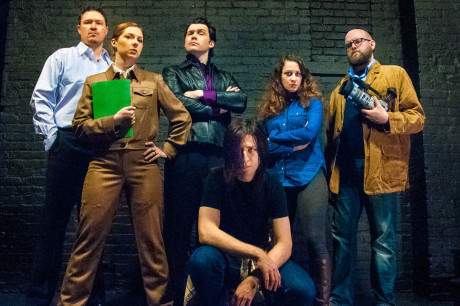There be eerie goings-on inside the DC Arts Center black box where Molotov Theatre Group is staging a spell-binder of a show about a psychic experiment to create a ghost by occultish committee. Although the horror play, titled The Margins, is short (just over an hour), it is long on suspense and double whammies—plus some preternaturally shrewd scripting by Playwright David Skeele.

Under Carl Brandt Long’s dextrous direction—which steadily grips us with increasing tension—six actors play characters in quest of a specter. They gather in the gloomy-musty maroon-walled parlor (built by Set Designer Rachel Marie Wallace, lit by Lighting Designer Pete Vargo) of an old, uninhabited mansion with a storied past. Five are quasi experts in the lore and luring of ghosts: Jonathan, the anxious host (Adam R. Adkins); Phyllida, a no-nonsense historian (Jen Bevan), who knows what lies buried in the basement beneath; Lane (Elliot Kashner), who has detected an unsettling level of mold on the premises; Trace (Yoni Gray), who was traumatized into muteness as a child by a sexual molester; and Helen, Trace’s sister (Katie Jeffries), who shares his past but can give voice to more than anyone could have imagined. Joining them is Markus, a jaded, just-the-facts reporter from the New York Times (Brian McDermott) who is there ostensibly to report but who involuntarily becomes part of the creepy story.
If you know your horror genre you can surmise that the psychics’ experiment goes awry and a ghost shows up who makes mayhem. Still the alarmingly uncanny story line will keep you guessing, and the effects will keep you on the edge of your seat.
Notable among those effects is the unnerving soundscape by Composer/Sound Designer Gregory Thomas Martin. If you weren’t already jumpy, it will jolt you there. Videographer Steven Bradford has devised an appropriately spooky opening credit sequence projected onto a screen above the mantle. And Bevan, doubling as costume designer, has outfitted this motley lot eclectically and cleverly. A video camera, which sometimes is operated hand-held as a prop, sends a live feed to the projection screen, lending a movie-like aura to the proceedings.
There was some opening night shakiness in the performances, and an unlucky glitch pitched the video into sleep mode a couple times, which distractingly brought up on screen a tech company logo. That can all surely be fixed, but ironically the tech accident, by momentarily taking my mind out of the scene, made me mindful with unexpected clarity of just how engrossed I had become in the storytelling and all its attendant effects.
The strength of Steele’s story is really the hook. It brings to life the disturbing past life of a young woman who lived on “the margins” of society, a servant girl who suffered horribly at the hands of the master of the mansion where this junk-science seance is set. Steele has constructed a back story for the play that in its own riveting way is more horrifying than anything that unfolds on stage. It is a crafty cri de coeur from a buried memory of sexual predation. And the Molotov production does it justice—even as the victim shows up to exact revenge.
I have seen and reviewed two previous Molotov productions of plays whose themes also turn on sexual violence in extremis: Extremities and Normal. Though I do not know whether this pattern of similarity was intentional, it strikes me as evidence of an extraordinary commitment on the part of theater artists whose esthetic is Grand Guignol—associated with graphic, amoral horror entertainment—to depict on stage real life’s horrors and hold their amorality up to clear-eyed view.
Bravo.
Running Time: About 65 minutes with no intermission.
The Margins plays through April 26, 2015 at Molotov Theatre Group performing at DC Arts Center (DCAC) – 2438 18th Street, NW, in Washington, DC. Performances are every Thursday, Friday, Saturday, and Sunday at 7:30 pm. For tickets, purchase them online.
LINKS
Do You Believe in Ghosts? An Explanation of the Horror Behind Molotov’s New Show, ‘The Margins’ by Alex Zavistovich.
Directing Molotov’s ‘The Margins’ – The Rules (?) of the Ghost Story by Carl Brandt Long.
‘The Nemo Effect and Music for Grand Guignol Theatre: Horror, Horror Everywhere’ by Gregory Thomas Martin.





